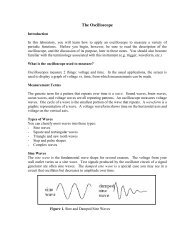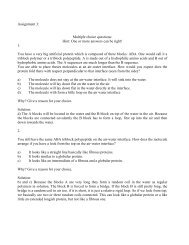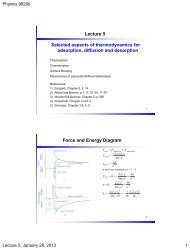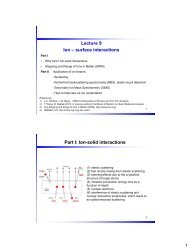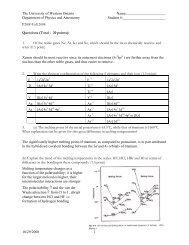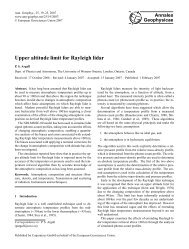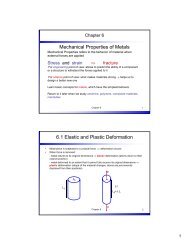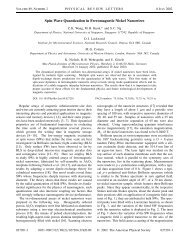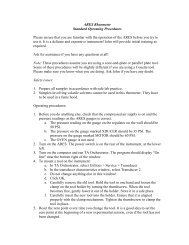1 Assignment 4: November 2 2009 Due date: November 13 2009 ...
1 Assignment 4: November 2 2009 Due date: November 13 2009 ...
1 Assignment 4: November 2 2009 Due date: November 13 2009 ...
Create successful ePaper yourself
Turn your PDF publications into a flip-book with our unique Google optimized e-Paper software.
<strong>Assignment</strong> 4:<br />
<strong>November</strong> 2 nd <strong>2009</strong><br />
<strong>Due</strong> <strong>date</strong>: <strong>November</strong> <strong>13</strong> th <strong>2009</strong><br />
Problems:<br />
1. Shown in Figure 1 is a portion of the H 2 O-NaCl phase diagram:<br />
Figure 1<br />
a) Using this diagram, briefly explain how spreading salt on ice that is on a temperature<br />
blow 0º C can cause the ice to melt.<br />
b) What concentration of salt is necessary to have 50% ice – 50% liquid brine at - 10 ºC?<br />
2. Consider a specimen of ice that is at – 10 º C and 1 atm pressure. Using Figure 2 , the<br />
pressure – temperature phase diagram for H2O, determine the pressure to which the<br />
specimen must be raised or lowered to cause it<br />
a) to melt and b) to sublime.<br />
Figure 2<br />
1
3.We were discussing the distribution function of the end-to-end distances of a polymer<br />
and have seen an example calculated for a chain made of 2000 C-C bonds in an ideal =<br />
good solvent (Tanford page 175).<br />
How will this distribution curve change by choosing a bad solvent?<br />
Describe it in words or draw a scheme.<br />
4. Imagine you have a macroscopic semi crystalline polymer sample. It has the form of a<br />
right angled box with dimensions 5 mm x 10 mm x 1 mm.<br />
The molecules are oriented or aligned parallel to the longest axis in the sample, because it<br />
had been drawn apart along that direction.<br />
You place this sample into a polarization microscope with the (10 mm x 5 mm)-face<br />
perpendicular to the optical path. What do you see? Which refractive index components<br />
are you probing here?<br />
Then you turn the sample by 90 degree so that the (10 mm x 5 mm)-face is perpendicular<br />
to the optical path? Any changes in the image? What refractive indices are probed now?<br />
Turn it again, so that the (1 mm x 5 mm)-face is perpendicular to the optical path. (Let's<br />
assume the microscope has enough space to do so and the sample does not fall over.)<br />
What refractive indices are probed now?<br />
Help: Draw a picture of the sample and the alignment direction of the polymer chains and<br />
define the refractive indices as well as directions in there!<br />
5. Does Tg increase or decrease if the characteristic ratio increases?<br />
6. Consider you have to design a band aid from a polymeric material that is supposed to<br />
be a drug delivery system for a fever drug. (Something like the "NIKOTINEL" - anti<br />
smoke band aids, which supplies nicotine to people how want to stop smoking or are not<br />
allowed to smoke, e.g. in a plane, but need nicotine.)<br />
What kind of polymer would you chose? Do not name a chemical formula; describe the<br />
physical characteristics of that polymeric material with the attributes you know so far.<br />
7. The Brewster angle (tan α Brewster = n(dielectric material)) is the angle where light with<br />
p-polarization is not back reflected into the air from a surface made out of a dielectric<br />
material. (Polarizers are used by photographers to diminish reflections on taking<br />
photographs from fish in an aquarium.)<br />
Imagine you have an unperturbed water surface (no waves). Water is a dielectric<br />
material, so you can point an expanded laser beam to that surface exactly under the<br />
Brewster angle in p-polarization. In addition you also have a screen which images the<br />
reflected light.<br />
a) What do you see on the screen if you have a clean water surface at the Brewster angle<br />
in p-polarization? What happens if you change to s-plarization?<br />
b) Imagine you put little tiny droplets of oil on the water surface. What do you see now<br />
under p-polarization? What happens now if you change the angle of the incoming laser<br />
beam?<br />
c) Imagine you have two molecules, which are immiscible with each other and which are<br />
both amphiphilic. Amphiphilic means that a molecule has a part which is hydrophilic<br />
(that part likes water and dissolves in it) and has a second part which is hydrophobic<br />
(does not like water and does not dissolve in it).<br />
2
You mix both molecules and dissolve the mixture with a very low concentration in a<br />
solvent which evaporates very quickly - say chloroform. This solution you drop very<br />
carefully onto your clean water surface in such an amount that the entire water surface<br />
will be covered by theses molecules in a monolayer. This process is called spreading.<br />
You give the system time to let the solvent evaporate. The film you formed is called a<br />
Langmuir-Blodgett film.<br />
What do you see now on your screen at the Brewster angle of clean water? And what<br />
happens if you change the incident angel of the laser beam?<br />
Please answer qualitatively. You do not need to calculate anything!<br />
8. When you want to pass a ray of light from an optically thick medium (e.g. water with n<br />
=1.33) to an optically thin medium (e.g. air with n = 1.0) your success depends on the<br />
angle of incidence onto that optical interface water/air. If you are above the critical angle<br />
of total internal reflection, all the light will be reflected from that surface, no beam can be<br />
transmitted or be refracted here. On the other hand if you are above the critical angle of<br />
total internal reflection and you look very closely to your interface now, you will find a<br />
film of light present on the low refractive index side of your interface in a thickness<br />
regime close to the wavelength of the used light. This is called an evanescent field. Could<br />
you see any use of such a film of light due to a total internal reflection? Or maybe the<br />
total internal reflection by itself can be of any use? Any idea? Of cause not necessarily at<br />
an air/water interface! You can choose any air/dielectric interface.<br />
I do not expect a specific answer. Just think about it and write it down.<br />
3



